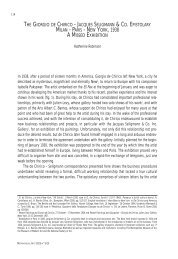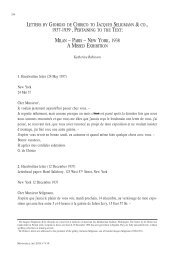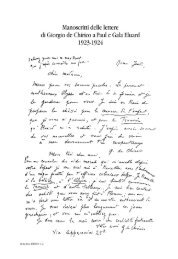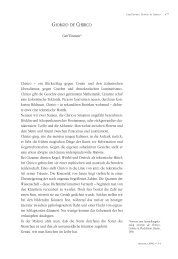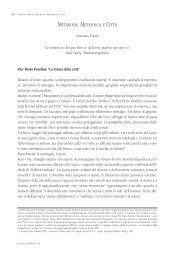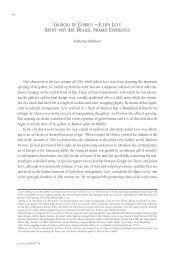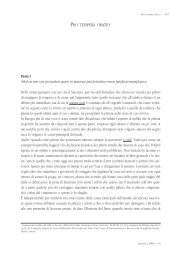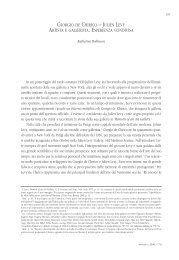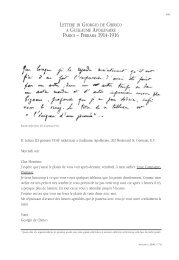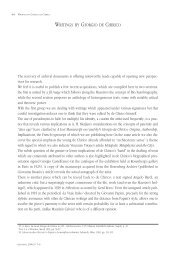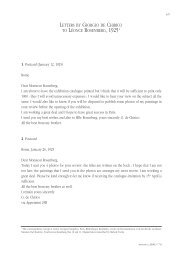Emplastic Oil - Fondazione Giorgio e Isa de Chirico
Emplastic Oil - Fondazione Giorgio e Isa de Chirico
Emplastic Oil - Fondazione Giorgio e Isa de Chirico
Create successful ePaper yourself
Turn your PDF publications into a flip-book with our unique Google optimized e-Paper software.
186<br />
SALVATORE VACANTI: FROM MURAL PAINTING TO “EMPLASTIC OIL”<br />
Finally, the Friulian painter Luigi Zuccheri 115 also merits mention. Of aristocratic origin, he <strong>de</strong>voted<br />
himself to painting only after resisting strong family pressure. He studied privately, away from<br />
the art aca<strong>de</strong>mies and from the main nuclei of Italian Avant-gar<strong>de</strong>. Nonetheless, during a long stay<br />
in Paris around 1930, Zuccheri became attracted to Surrealism. This experience together with his<br />
literary studies must have encouraged his <strong>de</strong>ep capacity for the fantastical. His painting is in appearance<br />
<strong>de</strong>scriptive, faithfully adhering to Nature, which is a constant theme of his: vast expanses of<br />
fields un<strong>de</strong>r cloudless or tempestuous skies with birds ready to migrate in the foreground, or the<br />
<strong>de</strong>piction of courtyard animals as resigned prisoners; fish from the rivers of Friuli and Venice’s<br />
Laguna are also sometimes <strong>de</strong>picted. His paintings might recall encyclopaedic illustrations, but on<br />
closer examination reveal elements of a transcen<strong>de</strong>nt reality (fig. 18). They evoke certain works of<br />
Savinio, De Pisis and <strong>de</strong> <strong>Chirico</strong>, but also the Old Masters, such as Brueghel the El<strong>de</strong>r and<br />
Hieronymus Bosch, who had inspired many other fantastical visions in European painting in the<br />
period between the two World Wars. 116<br />
Between 1940 and 1943, Zuccheri un<strong>de</strong>rwent a strong spiritual crisis brought on by the Second<br />
World War, which he translated into a stylistic metamorphosis. During this period he also experimented<br />
for the first times with the properties of paints and varnishes. Zuccheri in<strong>de</strong>ed abandoned the more<br />
“mo<strong>de</strong>rn” oil technique for the “historic” egg tempera technique. He began by rediscovering and studying<br />
ancient books on paint formulas, an exercise that further refined his research 117 , thus emulating<br />
the journey un<strong>de</strong>rtaken by <strong>de</strong> <strong>Chirico</strong> twenty years previously, when the latter championed the revival<br />
of “oil tempera”. The two artists finally met after the end of the war and initiated an active friendship<br />
centred around discussions on the secrets of tempera, also communicated in letters. 118<br />
Around 1947 Zuccheri bought a small property on the hills near Florence, where he soon <strong>de</strong>veloped<br />
close friendships with scholars, collectors and other artists. Sometime between 1947 and 1948<br />
Zuccheri met <strong>de</strong> <strong>Chirico</strong> at the home of Primo Conti, and thus initiated a relationship <strong>de</strong>cisive for<br />
his artistic maturation. It should be noted that it was in Florence in the very same period that <strong>de</strong><br />
<strong>Chirico</strong> assisted in the founding of Pittori mo<strong>de</strong>rni <strong>de</strong>lla realtà. Zuccheri was in fact the artist with<br />
whom <strong>de</strong> <strong>Chirico</strong> shared the greatest amount of similarities, whose allure he felt intensely and whom<br />
he esteemed for his particular interest in painterly technique. Many years later, at the <strong>de</strong>ath of the<br />
Friulian artist, <strong>de</strong> <strong>Chirico</strong> wrote:<br />
I admired [Zuccheri] for his passionate research into all the secrets of tempera, which is the origin of<br />
all painting […]. I often met him in Venice during my stays there and I spent consi<strong>de</strong>rable time in his<br />
studio discussing with him the secrets and advantages of tempera. He would tell me about his formu-<br />
115<br />
Luigi Zuccheri (Gemona <strong>de</strong>l Friuli, 1904 - Venice, 1974) took up painting after interrupting his literary studies. During a stay in Paris (1929-30) he<br />
became interested in Surrealism, without, however, forming a solid connection. Displeased with the painting of his youth, he retired to Friuli; between<br />
1933 and 1943 he <strong>de</strong>voted himself to technical and painterly research. He held his first solo exhibition in Trieste in 1939, which came to nothing due<br />
to the artist’s disillusionment with his own work. He took up painting again in the post-war period, still as a seclu<strong>de</strong>d painter in silent polemic against<br />
his times. See Luigi Zuccheri, exhibition catalogue, G. Perocco ed., Arti grafiche Friulane, Udine 1988.<br />
116<br />
See M. Fagiolo <strong>de</strong>ll’Arco, Dizionarietto per Zuccheri, in Zuccheri, edited by M. Fagiolo <strong>de</strong>ll’Arco, G. Vallese, Mondadori, Milan 1990, pp. 7-9.<br />
117<br />
See G. Vallese, Zuccheri, la maniera e il capriccio, in M. Fagiolo <strong>de</strong>ll’Arco, G. Vallese, op. cit., pp. 11-43.<br />
118<br />
As seen in the unpublished correspon<strong>de</strong>nce from 1952 to the <strong>de</strong>ath of Luigi Zuccheri in 1974, <strong>de</strong> <strong>Chirico</strong> encouraged his friend with notable expressions<br />
of esteem. I thank Professor Giulia Vallese for this information.<br />
METAPHYSICAL ART 2010|N° 9/10



